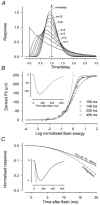Rod and cone contributions to the a-wave of the electroretinogram of the macaque
- PMID: 12562933
- PMCID: PMC2342654
- DOI: 10.1113/jphysiol.2002.030304
Rod and cone contributions to the a-wave of the electroretinogram of the macaque
Abstract
The electroretinogram (ERG) of anaesthetised dark-adapted macaque monkeys was recorded in response to ganzfeld stimulation and rod- and cone-driven receptoral and postreceptoral components were separated and modelled. The test stimuli were brief (< 4.1 ms) flashes. The cone-driven component was isolated by delivering the stimulus shortly after a rod-saturating background had been extinguished. The rod-driven component was derived by subtracting the cone-driven component from the mixed rod-cone ERG. The initial part of the leading edge of the rod-driven a-wave scaled linearly with stimulus energy when energy was sufficiently low and, for times less than about 12 ms after the stimulus, it was well described by a linear model incorporating a distributed delay and three cascaded low-pass filter elements. Addition of a simple static saturating non-linearity with a characteristic intermediate between a hyperbolic and an exponential function was sufficient to extend application of the model to most of the leading edge of the saturated responses to high energy stimuli. It was not necessary to assume involvement of any other non-linearity or that any significant low-pass filter followed the non-linear stage of the model. A negative inner-retinal component contributed to the later part of the rod-driven a-wave. After suppressing this component by blocking ionotropic glutamate receptors, the entire a-wave up to the time of the first zero-crossing scaled with stimulus energy and was well described by summing the response of the rod model with that of a model describing the leading edge of the rod-bipolar cell response. The negative inner-retinal component essentially cancelled the early part of the rod-bipolar cell component and, for stimuli of moderate energy, made it appear that the photoreceptor current was the only significant component of the leading edge of the a-wave. The leading edge of the cone-driven a-wave included a slow phase that continued up to the peak, and was reduced in amplitude either by a rod-suppressing background or by the glutamate analogue, cis-piperidine-2,3-dicarboxylic acid (PDA). Thus the slow phase represents a postreceptoral component present in addition to a fast component of the a-wave generated by the cones themselves. At high stimulus energies, it appeared less than 5 ms after the stimulus. The leading edge of the cone-driven a-wave was adequately modelled as the sum of the output of a cone photoreceptor model similar to that for rods and a postreceptoral signal obtained by a single integration of the cone output. In addition, the output of the static non-linear stage in the cone model was subject to a low-pass filter with a time constant of no more than 1 ms. In conclusion, postreceptoral components must be taken into account when interpreting the leading edge of the rod- and cone-driven a-waves of the dark-adapted ERG.
Figures














Similar articles
-
The d-wave of the rod electroretinogram of rat originates in the cone pathway.Vis Neurosci. 1999 Jan-Feb;16(1):91-105. doi: 10.1017/s0952523899161054. Vis Neurosci. 1999. PMID: 10022481
-
Characterization of the rod photoresponse isolated from the dark-adapted primate ERG.Vis Neurosci. 2001 May-Jun;18(3):445-55. doi: 10.1017/s0952523801183112. Vis Neurosci. 2001. PMID: 11497421
-
The contribution of human cone photoreceptors to the photopic flicker electroretinogram.J Vis. 2009 Mar 13;9(3):9.1-12. doi: 10.1167/9.3.9. J Vis. 2009. PMID: 19757948
-
Human retinal dark adaptation tracked in vivo with the electroretinogram: insights into processes underlying recovery of cone- and rod-mediated vision.J Physiol. 2022 Nov;600(21):4603-4621. doi: 10.1113/JP283105. Epub 2022 Jun 7. J Physiol. 2022. PMID: 35612091 Free PMC article. Review.
-
The rod-driven a-wave of the dark-adapted mammalian electroretinogram.Prog Retin Eye Res. 2014 Mar;39:1-22. doi: 10.1016/j.preteyeres.2013.12.003. Epub 2013 Dec 16. Prog Retin Eye Res. 2014. PMID: 24355774 Free PMC article. Review.
Cited by
-
Human Electroretinography Shows Little Polarity Specificity Following Full-Field Ramp Adaptation.Invest Ophthalmol Vis Sci. 2024 Aug 1;65(10):11. doi: 10.1167/iovs.65.10.11. Invest Ophthalmol Vis Sci. 2024. PMID: 39106057 Free PMC article.
-
Photoreceptor and postreceptor responses in congenital stationary night blindness.Invest Ophthalmol Vis Sci. 2013 Jul 10;54(7):4648-58. doi: 10.1167/iovs.13-12111. Invest Ophthalmol Vis Sci. 2013. PMID: 23761088 Free PMC article.
-
In vivo electroretinographic studies of the role of GABAC receptors in retinal signal processing.Exp Eye Res. 2015 Oct;139:48-63. doi: 10.1016/j.exer.2015.07.002. Epub 2015 Jul 8. Exp Eye Res. 2015. PMID: 26164072 Free PMC article.
-
The Beta Adrenergic Receptor Blocker Propranolol Counteracts Retinal Dysfunction in a Mouse Model of Oxygen Induced Retinopathy: Restoring the Balance between Apoptosis and Autophagy.Front Cell Neurosci. 2017 Dec 12;11:395. doi: 10.3389/fncel.2017.00395. eCollection 2017. Front Cell Neurosci. 2017. PMID: 29375312 Free PMC article.
-
Light-evoked responses of the mouse retinal pigment epithelium.J Neurophysiol. 2004 Mar;91(3):1134-42. doi: 10.1152/jn.00958.2003. Epub 2003 Nov 12. J Neurophysiol. 2004. PMID: 14614107 Free PMC article.
References
-
- Breton ME, Schueller AW, Lamb TD, Pugh EN., Jr Analysis of ERG a-wave amplification and kinetics in terms of the G-protein cascade of phototransduction. Invest Ophthalmol Vis Sci. 1994;35:295–309. - PubMed
-
- Bush RA, Sieving PA. A proximal retinal component in the primate photopic ERG a-wave. Invest Ophthalmol Vis Sci. 1994;35:635–645. - PubMed
-
- Cideciyan AV, Jacobson SG. Negative electroretinograms in retinitis pigmentosa. Invest Ophthalmol Vis Sci. 1993;34:3253–3263. - PubMed
Publication types
MeSH terms
Grants and funding
LinkOut - more resources
Full Text Sources

